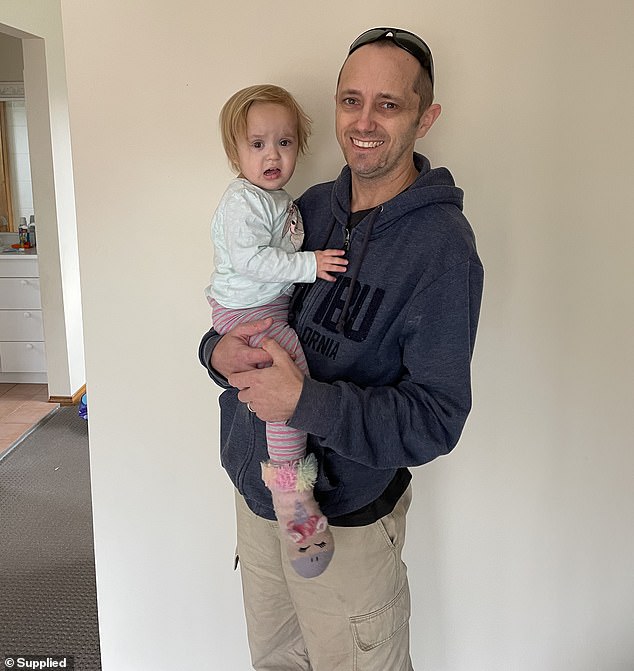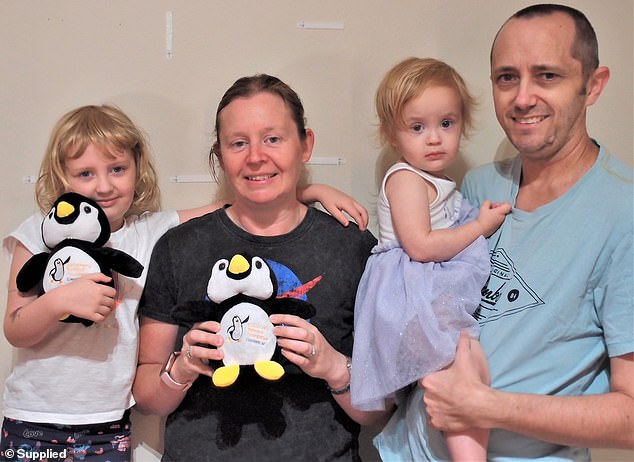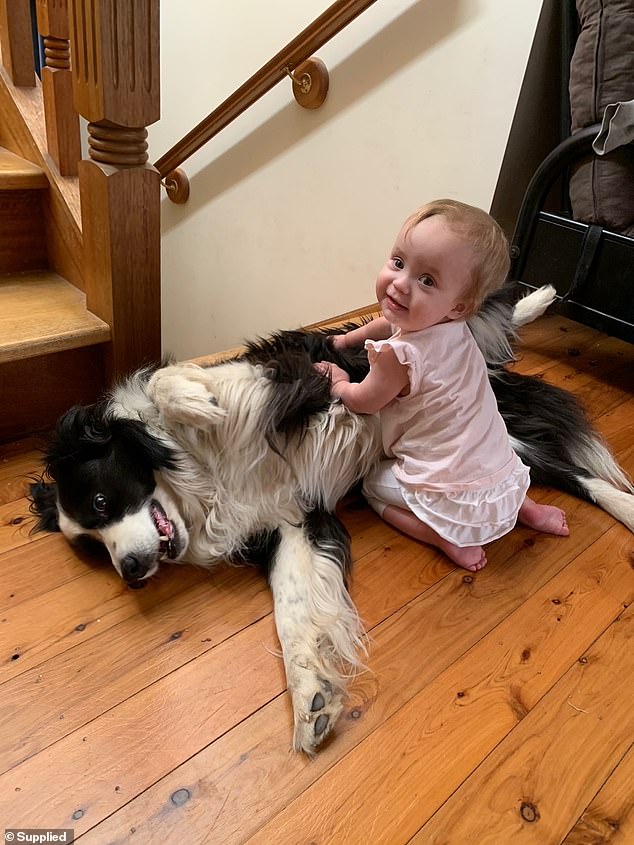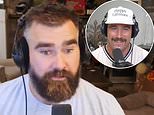Heartbreak as Aussie father-of-two who suffers from a genetic disease that causes tumours to grow only discovered it when his two-year-old daughter fell ill - and there is no cure
- An Australian dad has told of how he discovered he had Neurofibromatosis (NF)
- Nathan Coughlan's two-year-old daughter fell ill and underwent months of tests
- Doctors eventually determined she has the genetic and incurable NF1
- During Chloe's journey, the Sydney dad started to suspect he also had NF1
- At one of Chloe's appointments, doctors turned their attention to Nathan
- After a series of questioning they eventually confirmed the dad's diagnosis
A Sydney man has told of how he found out he was suffering from a genetic neurological condition after his young daughter was diagnosed.
Nathan Coughlan, 44, had no idea he had Neurofibromatosis (NF), and struggled with migraines, depression, learning difficulties, impaired sleep, occasional visual disturbances and ringing in the ears his whole life.
It wasn't until his two-year-old daughter, Chloe, was diagnosed with the genetic and incurable condition that doctors turned their attention to Nathan and determined he suffered from the same affliction.

Nathan Coughlan, 44, (pictured right) had no idea he had Neurofibromatosis (NF) until his two-year-old daughter, Chloe (pictured left) was diagnosed with the genetic and incurable condition
The father-of-two and his wife, Pam, took then one-year-old Chloe, who was suffering from severe constipation, to the emergency room where doctors noticed some strange birthmarks on her body.
'One of the doctors noticed café au alit birth marks all over her body and had mentioned Neurofibromatosis,' Nathan told FEMAIL.
Both Chloe and Nathan had what are known as cafe au lait marks which are flat areas of dark or brown skin that can occur anywhere on the body and, while harmless, can be indicative of a genetic condition.

Chloe had also missed some important developmental milestones which led doctors to believe there may be something more sinister at play and was diagnosed with NF1 when she was two
Chloe had also missed some important developmental milestones which led doctors to believe there may be something more sinister at play and started looking for a diagnosis.
Over the next few months Chloe was put through test after test and referral after referral during which time her development started to regress and she stopped talking.

Both Chloe and Nathan had cafe au lait marks which are flat areas of dark or brown skin that can occur anywhere on the body and, while harmless, can be indicative of a genetic condition
'She would go up to other kids and point at them and maybe verbalise some kind of baby babble but she had stopped doing that,' Nathan said.
By the time she was two it was finally determined she had Neurofibromatosis 1 - one of the three forms of the genetic condition in which non-cancerous tumors grow in the brain, spinal cord and nerves.
The symptoms are ranging, but generally include bone deformities, learning disabilities and high blood pressure and it unfortunately has no cure.
'The diagnosis was kind of a bit of a relief in a way now that we know what's going on and that we can finally get together a plan of action on how to manage Chloe,' Nathan said.
After asking Nathan a few questions at yet another appointment for Chloe, doctors started to suspect he may also have NF.
'They started asking me questions and then came to the conclusion that I've had it my whole life without knowing about it and unfortunately passed it on to Chloe.'
It came as 'no surprise' to Nathan that he also had NF1 after he had done a bit of research during Chloe's journey and he said the confirmation was bittersweet.
'I had answers as to why I am the way I am in a way,' he said.

Nathan (right) pictured with Chloe, his wife Pam (second left) and six-year-old daughter Maddison (far left) said the diagnosis gave him answers to 'why he is the way he is'
'After doing a bit of research on the condition and reading up on all the symptoms that kids with this have it made a lot sense with a lot of the struggles I had in school.
'I struggled with maths, making friends, social interaction with other kids.'
Nathan thinks he went undiagnosed due to a lack of awareness when he was young and the fact that his symptoms were less obvious.
'Maybe there wasn't as much knowledge around it with doctors back then or maybe they didn't think it was severe enough,' he said.
Nathan recently discovered he has osteoporosis - a lifelong condition in which the bones become weak and brittle and can fracture easily - which is common for people with NF1.

Nathan said it's 'hard' not knowing what will happen to Chloe, who is non-verbal, but has hope that with modern medicine rapidly progressing her outlook may improve
'As for Chloe, it's hard to know what she is experiencing as she is not able to communicate with us at this stage,' he said.
'It means pretty much the same as it does for me, regular check-ups with her GP but with a little more support from allied health professionals to get her to where she needs to be at her stage of life.'
The family are currently applying for NDIS support for Chloe who will need speech and occupational therapy as she grows up.
Nathan said it's 'hard' not knowing what will happen to Chloe but has hope that with modern medicine rapidly progressing her outlook may improve.
'We just have to manage the symptoms and other things as they manifest. We're not going to know how bad or good she's going to have it,' he said.
'Medicine's advancing constantly so hopefully by the time she gets to my stage there might be better treatment for it.'
May is Neurofibromatosis awareness month - to learn more about NF or donate to the cause, visit the Children's Tumour Foundation website here.
Most watched News videos
- Moment vigilante pickpocket hunter 'exposes criminals' in London
- Tim Walz quizzed over 'weapons of war' comments by CNN
- Paedophile arrested after he's caught sending explicit images to kids
- Barcelona Police skits reveal tricks employed by pickpockets
- 'We are dying, can you help us please?' Migrant's desperate 999 call
- Police and fire crews on site after road accident kills three in Wales
- CCTV shows moment stalker approaches Holly Newton before stabbing her
- The bloody battle for the hill Putin's desperate to capture
- Trump reveals how he will vote on Florida 6-week abortion ban
- David Axelrod weighs in on Kamala Harris' CNN interview
- Lib Dem leader wary of a proposed smoking ban 'going over the top'
- Trump weighs in on Kamala's long-awaited first interview







































































































































































































































































































































